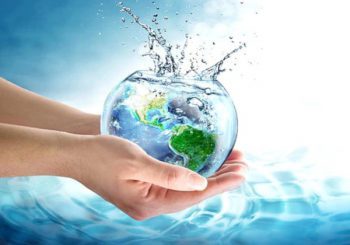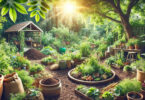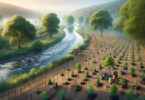By Jane Marsh
Guest Writer for Wake Up World
The U.S. Geological Survey (USGS) of the U.S. Department of the Interior (DOI) says that water makes up 71% of the earth. Although 96.5% comes from our oceans, water also appears in rivers and lakes, glaciers, aquifers, ground moisture, the air, and living organisms.
[pro_ad_display_adzone id=”110028″]
Earth’s water is recirculated naturally throughout the water cycle. Yet, the fact that it’s a renewable resource might make you wonder why there’s such an urgency to conserve it. Additionally, if water is finite, why are parts of the American West in the midst of their most critical water crisis yet?
You’ll need to understand how the water cycle works and the state of water worldwide to answer these questions.
An Overview of the Water Cycle
Water is the most essential resource that sustains life on earth. Appearing in three forms – solid, liquid, and gas – water connects the different parts of the climate system, including air, clouds, water bodies, vegetation, and colder regions.
The National Oceanic and Atmospheric Administration (NOAA) describes the process as water in constant motion throughout the planet and atmosphere. The evaporated liquid turns into water vapor, which subsequently becomes clouds. When the clouds release precipitation, rain and snowfall make their way back to the earth.
Water infiltrates the earth’s surface, seeping into the ground, plants, and larger water bodies, eventually evaporating again. Other times, water will freeze, as glaciers and ice caps, then become gases.
Water takes a long time to move through the cycle’s different phases. As a result, water allocation differs worldwide, posing a threat to future resource availability.
A Resource in Crisis: Why We Must Conserve Water
Unfortunately, global warming has disrupted the water cycle, which you might associate with recent heat waves, droughts, and increasing wildfires.
In the United States, 2021 was the driest year the southwestern states have ever experienced since they began recording data in 1895. Meanwhile, California’s 2020 fire season was the worst on record after burning 4,304,379 acres – over 4% of the state’s total land.
Climate change’s warmer temperatures have also prevented precipitation from replenishing drinking water reserves, increasing evaporation and causing water scarcity in desperate regions.
Nearly two-thirds of the global population already endures water shortages for at least one month out of the year. Additionally, 2 billion people have inadequate water supplies, with half the population expected to face water insecurity by 2025.
Point-source and nonpoint-source pollution is another reason why water conservation is critical. As the name suggests, point-source pollution is contaminants that enter the environment from direct sources we can point the finger at, such as factories, smokestacks, power plants, and discharge pipes.
The 2010 Deepwater Horizon oil spill is a prime example of point-source pollution. The explosion resulted in 3.19 million barrels of BP oil in the Gulf of Mexico, about 42 miles from the Louisiana coastline. Following the spill, BP, government agencies, scientists, and volunteers tried to control its residual effects on ecosystems and marine wildlife in the Gulf’s coastal communities.
Conversely, nonpoint-source pollution is far too complex to identify and correct. Stormwater runoff picks up chemical and waste particles from roadways, parking lots, and driveways, flows into sewer systems, and empties into local waterways.
Over time, this can pose severe threats to residential water supplies. Although advanced pump technologies allow homeowners to access clean water more than 25 feet below the surface, not every household can afford or utilize these tools.
Globally, 2 billion people drink polluted water, which poses a risk of severe health complications. Exposure to arsenic, lead, fracking chemicals, and agricultural runoff can lead to the development of various cancers, heart disease, reduced immunity, infertility, and cognitive decline.
Furthermore, records show that the most densely populated countries consume the most water, including the U.S., China, India, and Brazil – not all of which is for drinking.
According to the U.S. Environmental Protection Agency (EPA), power generation accounts for 45% of U.S. freshwater use, followed by irrigation at 32%. American families are also significant culprits of water overconsumption, using over 300 gallons daily per household.
While water is renewable, not all of it is clean or safe for human consumption. Coupled with the adverse effects of global warming and changes in weather patterns, we must conserve our most precious resource for survival.
How You Can Help
When viewing water conservation with a broader lens, it might seem impossible to singlehandedly be held responsible for safeguarding it for the world. However, the collective efforts of individuals can make a significant difference in protecting the water where you live.
Some ways you can help to conserve water include:
- Check your home’s faucets and valves for leaks – a family can waste 9,400 gallons of water annually from a leaky toilet or sink.
- Upgrade your water appliances – toilets, faucets, showerheads, dishwasher, and laundry machines – to low-flow, efficient models.
- Take shorter showers – shaving off one minute could save 900 gallons of water each year.
- Turn off the water while brushing your teeth.
- Adjust your sprinklers to aim for your lawn only and install a timer.
- Plant drought-resistant trees, shrubs, and flowers that require little irrigation.
- Sweep debris off your driveaway as opposed to hosing it down.
- Only run full loads of dishes and laundry.
Most importantly, don’t pour or flush household cleaners, drugs, and other chemicals down the drain – also known as perfluoroalkyl and polyfluoroalkyl substances (PFASs). The EPA has identified over 9,000 PFAS compounds, of which 600 appear in everyday products like cookware, cosmetics, and dental products.
Also referred to as “forever chemicals,” PFAS compounds could take thousands of years to break down, contaminating our drinking water supply and making it unsafe to consume.
Protecting Our Water Resources Is Critical
Just because water is renewable doesn’t mean it’s always available as we need it. It may not always be clean, safe, and in ample supply where we live. After years of depleting our most precious reserves, it’s become more critical to conserve enough water to sustain life on earth.
About the author:
 Jane is the founder and editor-in-chief of Environment.co where she shares practical tips on how to live a greener life.
Jane is the founder and editor-in-chief of Environment.co where she shares practical tips on how to live a greener life.
[pro_ad_display_adzone id=”110027″]





